- LA SOBREMESA
- Posts
- #5 Sunflower oil to dress a tomato salad? Someone pinch me
#5 Sunflower oil to dress a tomato salad? Someone pinch me
A tomato salad experiment that humbled my Spanish ego — and actually taught me something. (+4 spanish salad recipes for the summer)
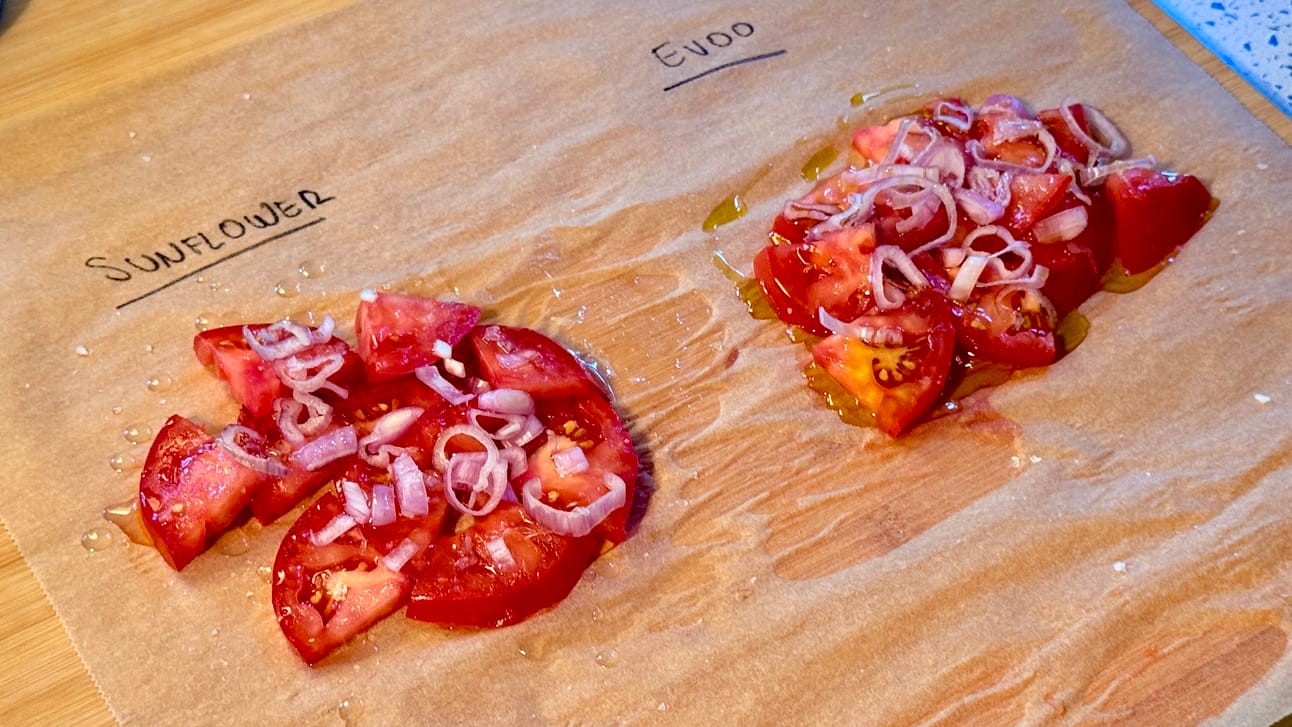
A couple of days ago, I posted a TikTok making a simple — yet one of the best things on earth — tomato salad… which I actually recorded a year ago but never posted. And it went surprisingly viral:
@cookingfromspain Y el resto?
A beautiful “Coeur de bœuf” tomato, and honestly, not much more: a little bit of sliced garlic, fresh julienned onion, sea salt flakes, and an unreasonable amount of extra virgin olive oil. The salt makes the tomato sweat a little, and that liquid mixed with the olive oil is just pure fantasy. Just make sure you’ve got good bread to soak it all up 😎🤌
I got plenty of comments suggesting other toppings like cucumber, coriander, feta cheese, olives, canned tuna… All great ideas!
But if you belong to, live in, or have lived near the Mediterranean Sea, you know that a salad of this vibe — when the tomato is seasonal and exceptionally good — really doesn’t need anything else.
In fact, you don’t want to include anything that might overpower it… right? Well, that’s exactly what all these people meant, but with a concept that I would never even think of:
 | 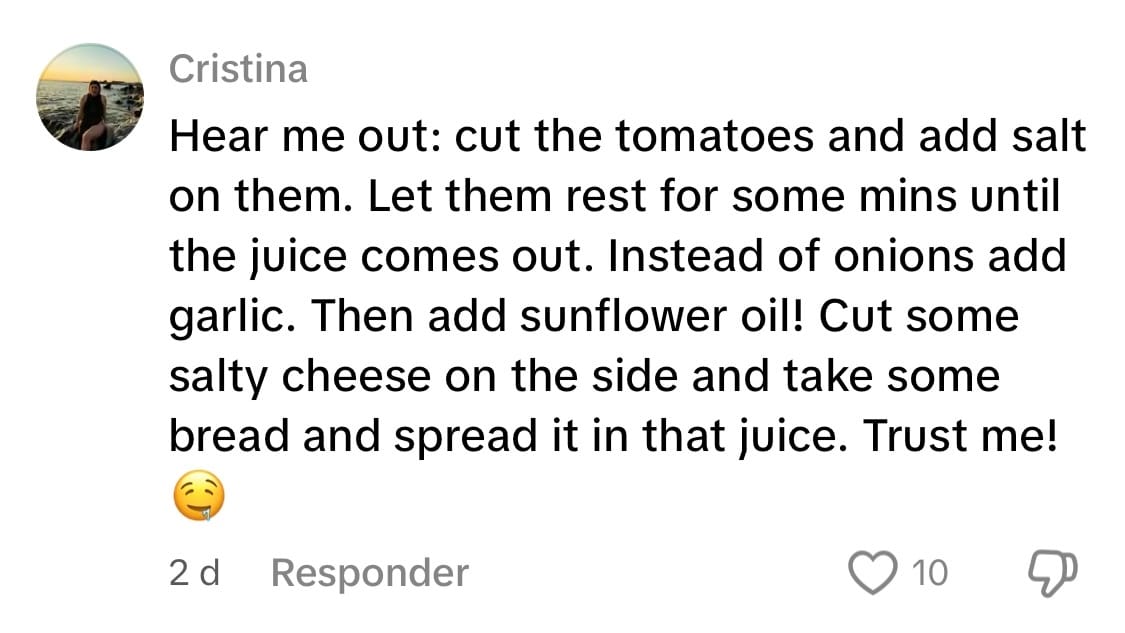 |  |
When I read the first comment saying this… I honestly didn’t even take it seriously. As a Spaniard, there is no f* way you’re going to convince me to use sunflower oil in my tomato salad instead of good olive oil.
At least that’s what I thought. But the comments kept coming. And most importantly, one user said something that really represents my way of thinking — in the kitchen and in life. Right after someone said what I was thinking (that it was ridiculous), she said: ‘‘Tried it?’’.
Checkmate. She’s right! So I did what I had to do as a gastro enthusiast: set aside my proud Spanish ego and try it out.
👉 Before I tell you what I found, I challenge you to do the same.
Next time you have the opportunity, take two versions of your tomato salad — one with olive oil, one with sunflower oil — and taste them side by side. See how each oil changes (or doesn’t change) the flavor. It’s a fun little experiment, and I’d love to hear what you think.
Remember!
You can always answer to this email -or comment at the bottom of each article- to give me feedback, share your thoughts, etc. I will be super happy to read it!
So, here’s what I did:
I took a pretty basic tomato I had at home — supermarket-bought, not the best quality — and made myself two salads: tomato, a little bit of shallots, a good pinch of sea salt and… one with extra virgin olive oil, the other with sunflower oil.
Okay, not gonna lie: I liked it better with EVOO. But let me tell you something… I was actually surprised by the other one.
The reality is that, yes, the sunflower oil doesn’t overpower the tomato — its flavor remains the main character. The extra virgin olive oil actually changes the flavor of the whole salad… but to something better, to be honest 😂.
BUT! I must say a couple of things about this test:
I didn’t use the best quality tomato. Its flavor was nothing special.
I used a refined sunflower oil, not extra virgin (I honestly didn’t even know it existed haha).
As I said at the beginning of this article… it does make sense not to want to alter the flavour of a good seasonal tomato. Right? That’s why we all agreed not to add too much toppings to a salad of this kind.
Maybe… even though with EVOO we are adding a delicious touch to the salad, we are indeed changing the flavour of the tomato.
Maybe… when the product deserves it, we should try not to. I don’t know… But I will definetely try again with a decent tomato and a decent sunflower oil.
So yeah — sometimes, we need to let go of our gastro ego
Even if something sounds wrong at first, giving it a shot might surprise you. That’s how we grow… in the kitchen and beyond. Tasting something new doesn’t mean betraying what you love… it just means you’re staying curious. And, honestly, that’s where the magic usually happens.
Thanks for reading, and don’t forget to leave a comment if you enjoyed it!
Recipes of the week
The Spanish cookbook is full of delicious summer dishes that celebrate seasonal ingredients while helping us survive the extreme heat. Here are four of my favorites! (Of course, there are many more worth exploring — but don’t worry, we’ve got plenty of time to talk about them in the coming weeks.)
Before the recipes, let me remind you my new youtube video, where I explain step by step my three favourite summer salads from Spain!
Papas aliñás
A classic salad from the south of Spain, with many regional variations. So simple, so cheap, but sooo good!
I focused on the Cádiz version. Traditionally, papas aliñás are meant to be just potatoes, fresh onion, and a simple dressing of extra virgin olive oil, sherry vinegar, and salt.
That said, adding a bit of parsley, canned tuna, and hard-boiled egg is always a good idea, if you ask me. One more thing worth mentioning: in the region, it's typical to use melva instead of tuna — a smaller fish from the tuna family with a slightly different texture.
Ingredients for 2 servings:
3 potatoes (400 g) — better waxy potatoes, low in starch, that retain their shape after boiling.
1 red onion finely chopped (60 g) — In Spain, it’s common to find fresh onions — called cebolletas — that work perfect in this salad. If not, a red or sweet onion will do the job.
2 hard boiled eggs
1 tuna can in olive oil (150 g) — Yes, the olive oil also goes in.
One bunch of fresh parsley
Extra virgin olive oil
Sherry vinegar
Salt
Method
This recipe is really simple. Just cook the potatoes, with skin, until soft. Peel them and cut them into bite-size chuncks. Chop the onion and the parsley, and mix everything together on a big bowl to spread all the dressing evenly.
The only thing you need to know: YOU MUST DRESS IT WHILE STILL HOT. This way, the dressing is absorbed by the potatoes, the onion slightly loses its bitterness, and the final flavour is just great.
So, while the potatoes are cooking, make sure you prepare the rest of the ingredients. And then… try not to burn your fingers, but rush a little bit!
Let it cool down to room temperature before eating.
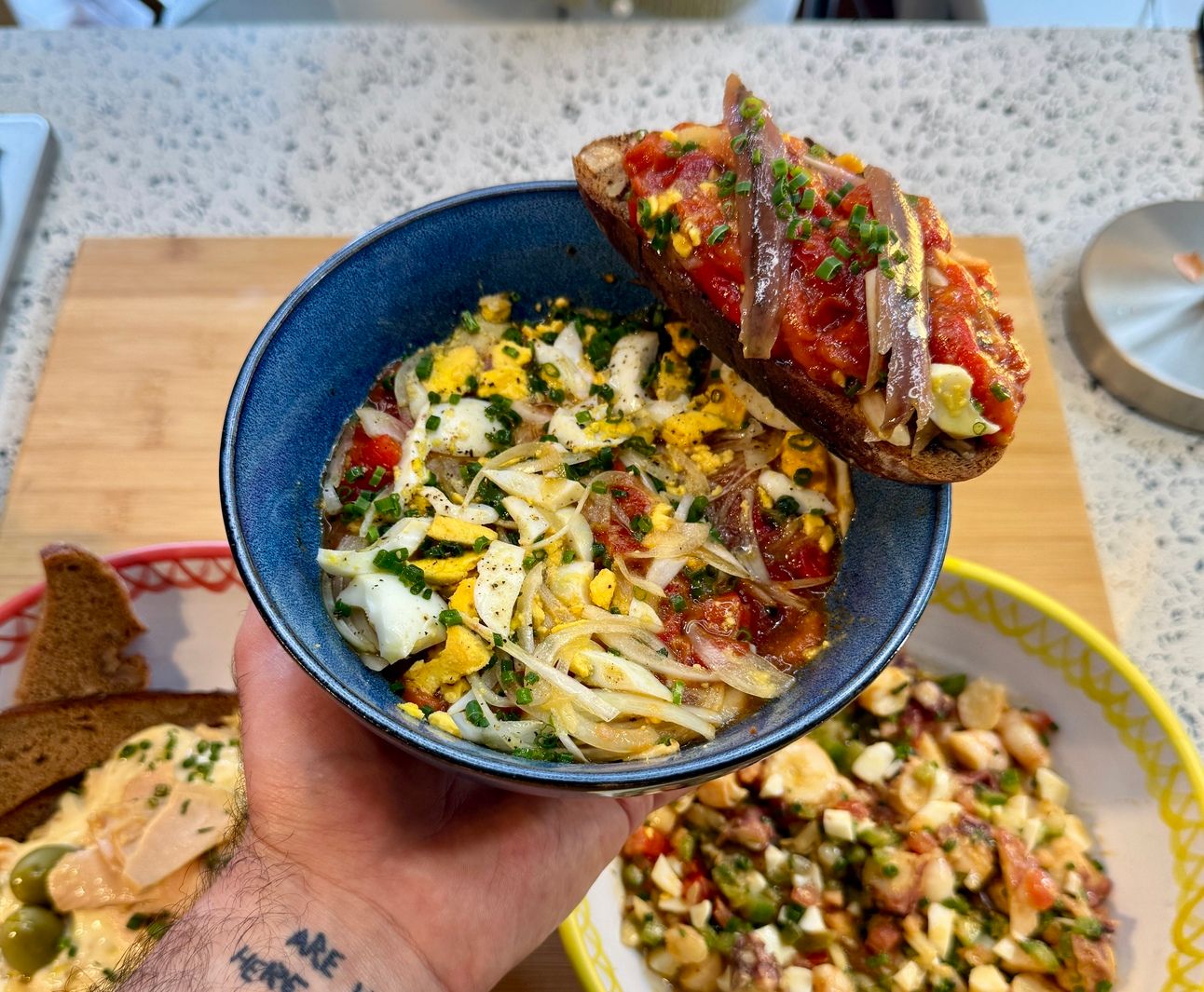
Zorongollo extremeño
This recipe will surprise you! Roasting veggies only to cool them down and eat them chilled might sound strange… but believe me, it feels like heaven on a hot summer day.
Don’t mistake this for Zarangollo from Murcia, which is basically scrambled eggs with courgette, onion, and sometimes potatoes.
Ingredients for 3-4 servings
3 red bell peppers (600 g)
1 tomato
1 garlic bulb
A bunch of chives
1 hard boiled egg
Half an onion, thinly sliced
Optional: a nice piece of toast and an anchovy as the cherry on top
Method
Place the peppers and the tomato on a tray with a splash of olive oil and a pinch of salt. Do the same with the garlic, but wrap it in aluminium foil to prevent it from burning. Roast everything at 190 °C for one hour. Don’t worry if the skin burns—that’s exactly what we’re looking for.
Once out of the oven, cover the peppers and tomato with plastic wrap and let them cool down. This will make them sweat, which makes peeling a breeze. Remove the skins and the seeds from the peppers (you can remove the tomato seeds too, but I personally don’t think it’s necessary).
Cut the top off the garlic bulb and squeeze out all that sweet, roasted goodness. Blend it together with the tomato, a pinch of salt, olive oil, and the liquid released by the roasted veggies. This will be your dressing.
Tear the peppers into strips with your hands, mix them with the tomato, and your base is ready.
To serve, place the veggie base on a plate and top with the sliced onion, the hard-boiled egg, chopped chives, and a final splash of olive oil.
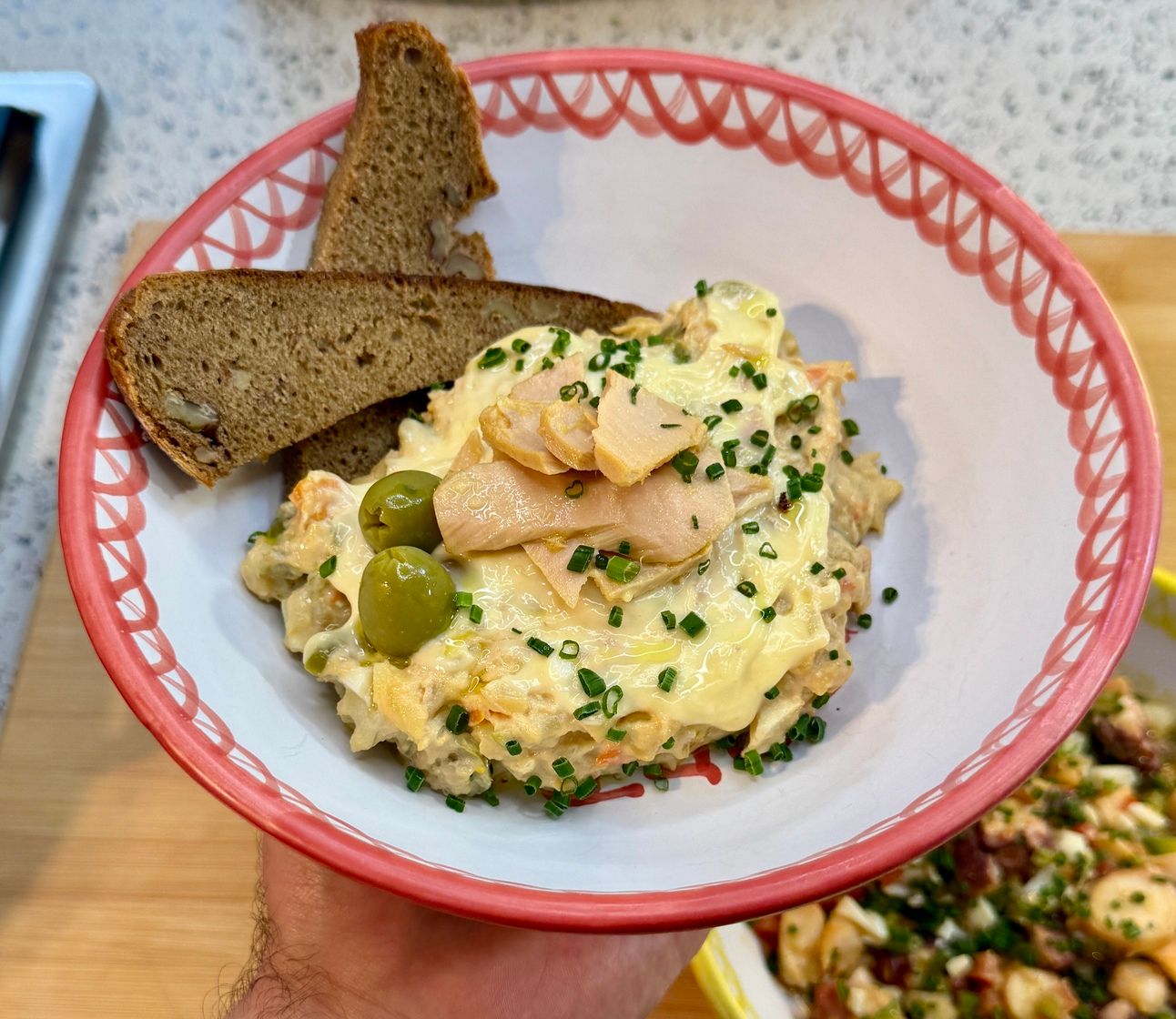
Ensaladilla rusa
Definetely, my favourite. The spanish twist on the classic “Olivier” salad — basically, a potato salad dressed with mayonnaise.
In Spain, the addition of good canned tuna in olive oil is mandatory. After that, there are countless variations depending on the region and the personal taste of each chef.
For me, a proper ensaladilla rusa must be an elegant yet vibrant mix of flavours and textures — and it should always come with some bread (or something similar) to scoop it up.
As for ingredients: potato, carrot, hard-boiled egg, canned tuna in olive oil, and olives are non-negotiable in my opinion. After that... I like to throw in a bit of finely chopped sweet onion — it adds a lovely crunch. Same goes for variante, a mix of diced pickled veggies you can usually find in Spanish supermarkets. (I didn’t include it in this recipe because it’s tricky to find outside of Spain… but sour pickled things work great if you want to innovate — think capers or gherkins.)
Some people also add green beans or green peas. I don’t mind them, but a large part of the Spanish gastronomic community would strongly disagree.
Now, the key element — the mayonnaise.
Sure, you can make a basic ensaladilla with store-bought mayo (and honestly, there are a couple of Spanish brands I find pretty decent — my fave is called Musa).
But if you want a next-level ensaladilla, make your own mayo. And most importantly: use the oil from the tuna can in it. I also like to add one or two anchovies for that umami kick, and a good sherry vinegar to give it the tang that separates a decent ensaladilla from a true masterpiece.
Here’s the recipe that’ll make you love ensaladilla as much as I do:
Ingredients (4–6 servings)
330 g boiled potatoes
100 g boiled carrots
70 g finely chopped sweet onion
85 g sliced green olives
150 g canned tuna in olive oil — The star of the show! Quality here matters, so use a brand you trust.
2 hard-boiled eggs
For the perfect mayonnaise:
250 g oil — use all the oil from the tuna can, and top up with sunflower oil until you reach 250 g
1 egg yolk
40 g sherry vinegar
2 anchovies
A pinch of the oil of the anchovies
Making homemade mayo is incredibly easy with a hand blender. Just make sure all ingredients are at room temperature — that way you avoid the dreaded split mayo.
Place all ingredients in a tall container, insert the blender all the way to the bottom, and blend without moving it. In a few seconds, the mixture at the bottom will turn white and thick. Once that happens, move the blender gently up and down to emulsify everything evenly.
I like to cube the potatoes and gently mash them in a bowl so they partially break down. Then, toss in the rest of the ingredients, give it a gentle mix, and enjoy the best potato salad in the world. 😎🫡
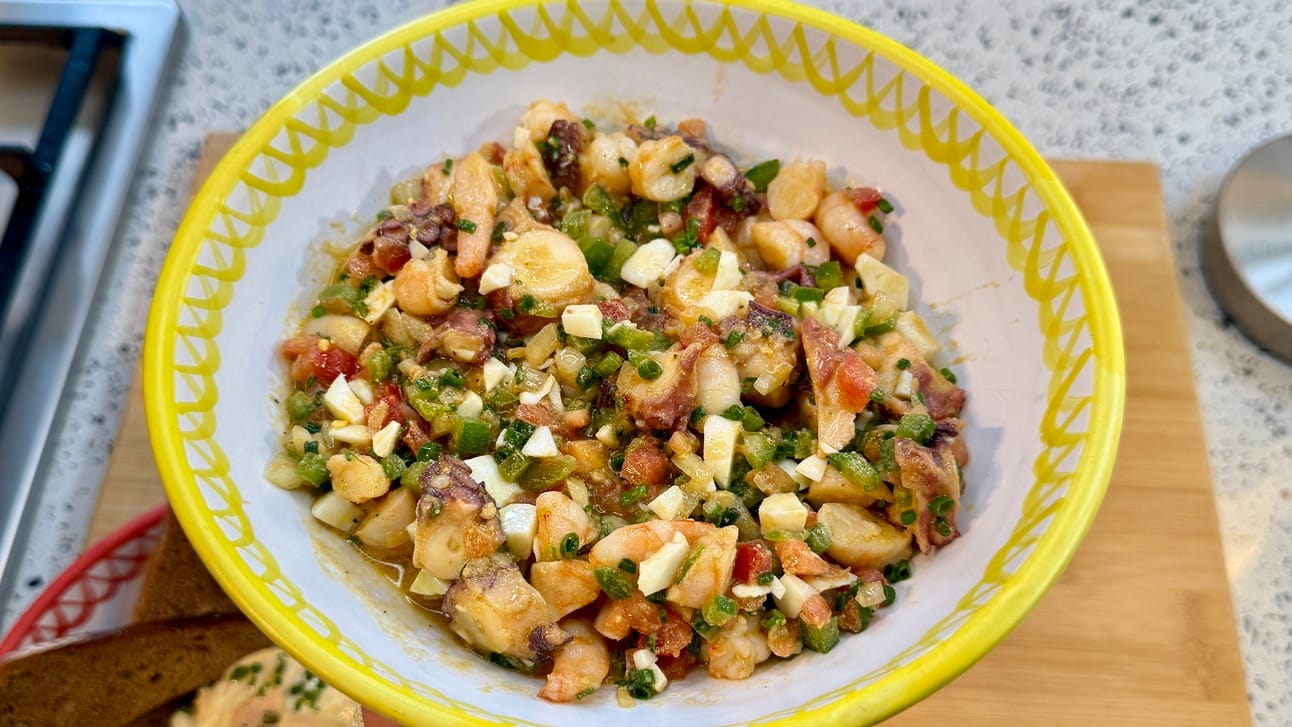
Salpicón de marisco
The fancy version of spanish salads.
Think of it as a seafood salad with a veggie vinaigrette that ties everything together — bright, fresh, and full of Mediterranean vibes.
For this version, I used octopus and prawns — mostly because they were the only ones I could find with decent quality that day. But honestly, the base is super flexible. Go wild with what you have on hand: surimi, mussels, crab, even white fish like monkfish work beautifully here.
And I’ll say it again (because it’s important): make this salad the day before. Let it rest in the fridge for 12 hours so all the flavours have time to connect and balance out. The transformation is wild — from “okay, this is nice” to “holy sh*t, what did I just eat?”
Ingredients (4–6 servings)
200 g cooked octopus
250 g cooked prawns
150 g onion
150 g green bell pepper
100 g tomato
A good bunch of chives
4 hard-boiled eggs
6 g salt
20 g extra virgin olive oil
2 g black pepper
40 g sherry vinegar (or whatever good vinegar you have on hand)
Method
Dice the onion, bell pepper, and tomato into small cubes. Add the salt and olive oil, and let them marinate for 15–20 minutes. Then strain and save that flavourful liquid — it’s going into the dressing later.
Finely chop the chives. Separate the yolks from the egg whites, and chop the whites into small pieces. Mix the egg whites with the marinated veggies and the seafood, all cut into bite-sized pieces.
Now for the dressing: blend the strained veggie liquid with the egg yolks, vinegar, and black pepper. Whisk until smooth — it should be creamy, punchy, and packed with flavour.
Mix everything together, cover, and let it chill overnight in the fridge.
Trust me — it’ll be worth the wait.

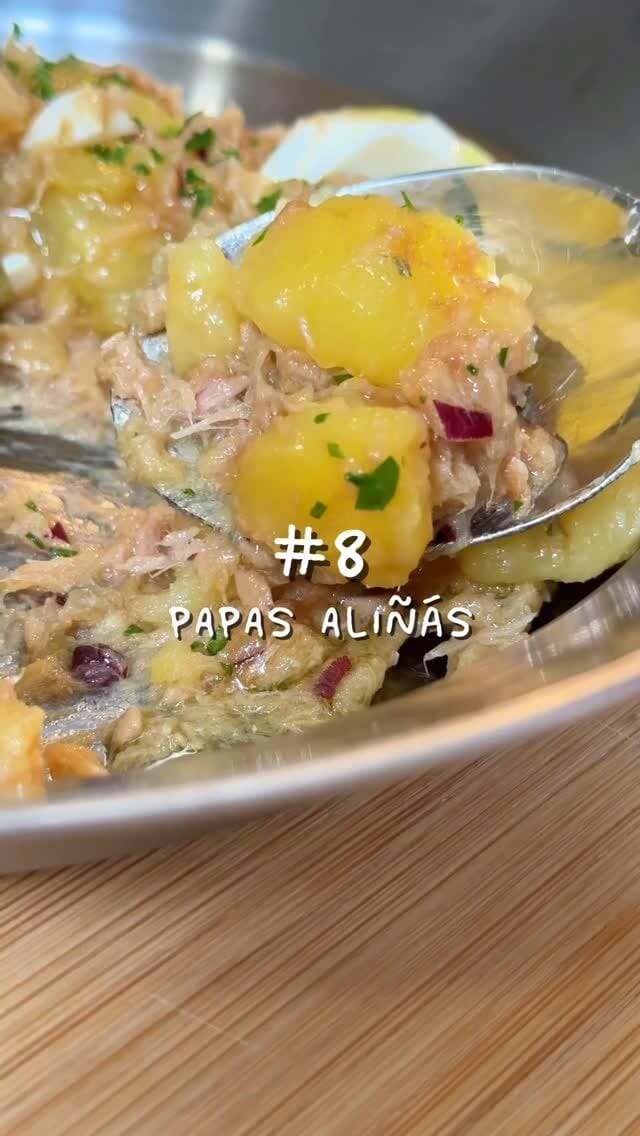

Reply